How Will The Population Of Birds Change Over The First Few Years
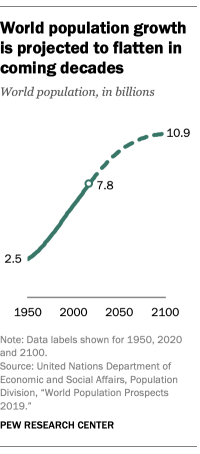
For the offset fourth dimension in modernistic history, the world's population is expected to virtually stop growing by the end of this century, due in large role to falling global fertility rates, according to a Pew Research Center analysis of new data from the Un.
By 2100, the world's population is projected to achieve approximately 10.nine billion, with annual growth of less than 0.1% – a steep reject from the electric current rate. Betwixt 1950 and today, the world'southward population grew between one% and 2% each year, with the number of people rising from 2.v billion to more than than vii.seven billion.
Here are 11 key takeaways from the UN's "World Population Prospects 2019":
The global fertility rate is expected to be one.9 births per woman past 2100, downwards from 2.5 today. The rate is projected to fall beneath the replacement fertility rate (2.1 births per woman) by 2070. The replacement fertility charge per unit is the number of births per adult female needed to maintain a population's size.
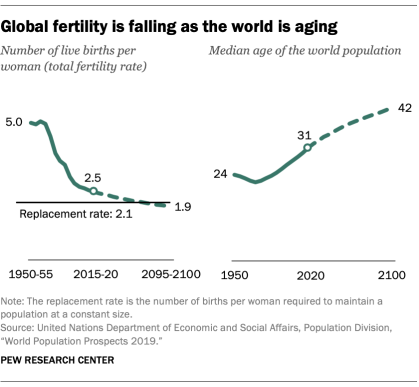
The world'south median age is expected to increment to 42 in 2100, up from the electric current 31 – and from 24 in 1950. Betwixt 2020 and 2100, the number of people ages 80 and older is expected to increase from 146 million to 881 million. Starting in 2073, there are projected to exist more than people ages 65 and older than under age 15 – the first time this volition exist the example. Contributing factors to the rise in the median age are the increase in life expectancy and falling fertility rates.
Africa is the just globe region projected to have strong population growth for the remainder of this century. Betwixt 2020 and 2100, Africa's population is expected to increment from 1.3 billion to iv.3 billion. Projections bear witness these gains will come mostly in sub-Saharan Africa, which is expected to more than triple in population by 2100. The regions that include the United states and Canada (Northern America) and Australia and New Zealand (Oceania) are projected to grow throughout the rest of the century, too, but at slower rates than Africa. (This analysis uses regional classifications from the United nations and may differ from other Pew Inquiry Center reports.)
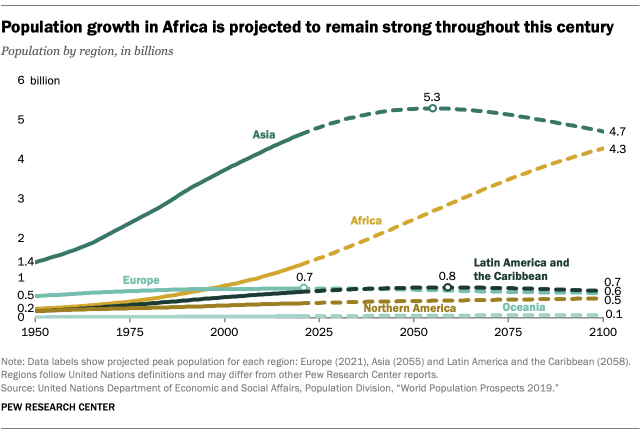
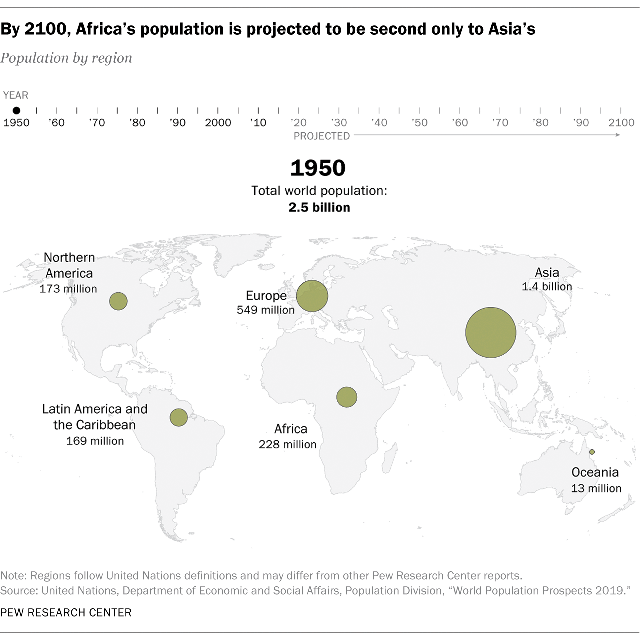
Europe and Latin America are both expected to take failing populations past 2100. Europe's population is projected to peak at 748 million in 2021. The Latin America and Caribbean area region is expected to surpass Europe in population by 2037 before peaking at 768 million in 2058.
The population of Asia is expected to increase from four.6 billion in 2020 to 5.3 billion in 2055, then start to decline. Communist china's population is expected to elevation in 2031, while the populations of Nippon and South korea are projected to pass up after 2020. India's population is expected to grow until 2059, when it volition reach one.7 billion. Meanwhile, Indonesia – the almost populous land in Southeastern Asia – is projected to reach its peak population in 2067.
In the Northern America region, migration from the residue of the world is expected to be the primary driver of connected population growth. The immigrant population in the United States is expected to see a internet increase of 85 million over the next lxxx years (2020 to 2100) according to the UN projections, roughly equal to the full of the next 9 highest countries combined. In Canada, migration is likely to exist a key driver of growth, every bit Canadian deaths are expected to outnumber births.
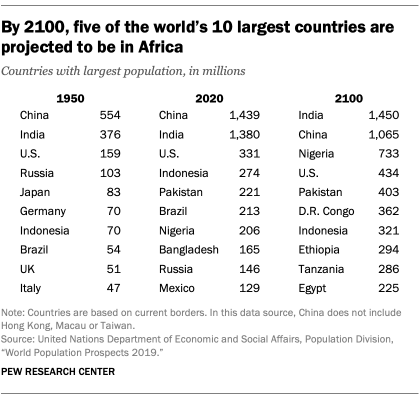
Six countries are projected to business relationship for more than half of the world'due south population growth through the finish of this century, and five are in Africa. The global population is expected to grow by about 3.1 billion people between 2020 and 2100. More than half of this increase is projected to come from Nigeria, the Democratic Congo-brazzaville, Tanzania, Federal democratic republic of ethiopia and Angola, forth with i non-African country (Islamic republic of pakistan). Five African countries are projected to exist in the globe'south top 10 countries by population by 2100.
India is projected to surpass Communist china every bit the globe'south most populous country past 2027. Meanwhile, Nigeria will surpass the U.Southward. as the third-largest country in the globe in 2047, according to the projections.
Betwixt 2020 and 2100, 90 countries are expected to lose population. 2-thirds of all countries and territories in Europe (32 of 48) are expected to lose population by 2100. In Latin America and the Caribbean, one-half of the region's 50 countries' populations are expected to shrink. Between 1950 and 2020, by dissimilarity, only six countries in the world lost population, due to much higher fertility rates and a relatively younger population in past decades.
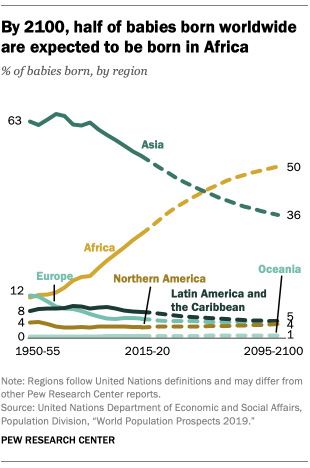
Africa is projected to overtake Asia in births by 2060. Half of babies born worldwide are expected to exist built-in in Africa past 2100, up from three-in-ten today. Nigeria is expected to take 864 million births betwixt 2020 and 2100, the virtually of any African land. The number of births in Nigeria is projected to exceed those in Communist china by 2070.
Meanwhile, roughly a third of the world's babies are projected to be born in Asia by the end of this century, downwardly from nearly one-half today and from a peak of 65% in the 1965-lxx period.
The Latin America and Caribbean region is expected to have the oldest population of any world region by 2100, a reversal from the 20th century. In 1950, the region's median historic period was just xx years. That figure is projected to more than double to 49 years past 2100.
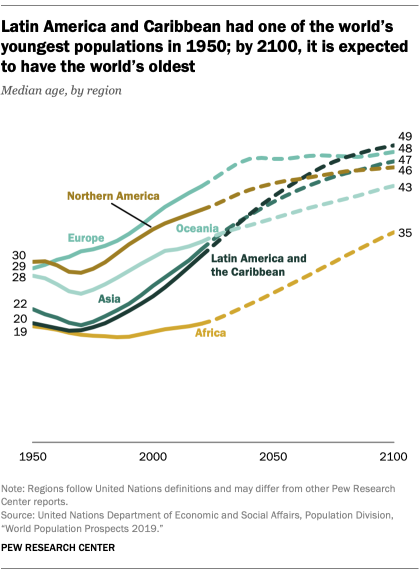
This design is axiomatic when looking at individual countries in the region. For example, in 2020, the median ages of Brazil (33), Argentina (32) and Mexico (29) are all expected to exist lower than the median age in the U.S. (38). Nevertheless, by 2100, all iii of these Latin American nations are projected to exist older than the U.S. The median age will exist 51 in Brazil, 49 in Mexico and 47 in Argentine republic, compared with a median age of 45 in the U.S. Colombia is expected to undergo a peculiarly stark transition, with its median historic period more than tripling betwixt 1965 and 2100 – from sixteen to 52.
Japan is projected to have the highest median historic period of whatever land in the world in 2020, at 48 years old. Japan'southward median historic period is expected to go along to rising until it peaks at 55 in 2065. It is expected to be lower in 2100 (54). By that time, the state with the highest median historic period is expected to be Albania, with a median age of 61.
Correction: This post has been updated to clarify that Republic of india is expected to get the world'southward near populous country by 2027. Past 2059, its population is projected to peak at 1.7 billion.
Annotation: The UN projections for the future population are based on assumptions near likely future changes in key demographic indicators, including fertility, life expectancy and migration. In that location is uncertainty regarding specific estimates. This assay uses the medium variant for future dates, which takes the midpoint of likely outcomes. For more than information, run into the full United nations report, data tables and methodology .

Anthony Cilluffo is a former research analyst who focused on social and demographic trends at Pew Inquiry Centre.

Neil G. Ruiz is an acquaintance managing director of race and ethnicity research at Pew Inquiry Center.
Source: https://www.pewresearch.org/fact-tank/2019/06/17/worlds-population-is-projected-to-nearly-stop-growing-by-the-end-of-the-century/
Posted by: romerobeatee.blogspot.com


0 Response to "How Will The Population Of Birds Change Over The First Few Years"
Post a Comment